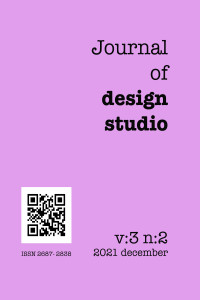A Design Task for Sivas Grand Mosque’s Minaret: Vertical Construction/Formal Articulation/Visual Stimuli
Abstract
As well as a design process, experimental practices in architectural education are associated with the analytical approaches of visual thinking and visual reasoning. The main purpose of this study was to explore creative methods for devising a vertical construction through visual reasoning. In terms of experimental practices, design research is based on exploration while the primary research area in architecture is reframed by constantly renewed approaches. Accordingly, the hypothesis of this study was that creative methods would improve when the creation of a vertical construction in architectural education is nourished by visual stimuli. The study searched for a construction that plasticized the vertical spatiality of Sivas Grand Mosque’s minaret. The method was shaped by a prerequisite dialogue that rests on visual stimuli. The expected outcome of this dialogue was that the minaret as a pure form would be subjected to an abstraction and, a design proposal then developed for its current structural problems. The results indicated a two-fold appreciation of design. First, when the minaret was maintained within the idea of stabilization rather than being construed as a pure form, the search for a creative method of vertical construction was handled in the context of static preservation. Second, when Sivas Grand Mosque’s minaret as an imaginary design tool was construed as a pure form and the abstraction level increased through visual reasoning, the outcomes gradually demonstrated an approach akin to experimental practices.
Supporting Institution
-
Project Number
-
Thanks
-
References
- Akin, Ö. (2008). Frames of reference in architectural design: Analyzing the hyper-acclamation (A-h-a-!). Carnegie Mellon University Research Showcase, October, 1-20.
- Alexander, C. (1973). Notes on the synthesis of form. Cambridge, Massachusetts: Harvard University Press.
- Anderson, R. E., & Helstrup, T. (1993). Visual discovery in mind and on paper. Memory & Cognition, 21(3), 283-293.
- Arnheim, R. (2009). Görsel düşünme (R. Öğdül, Trans.). İstanbul: Metis Yayınları.
- Daniels-McGhee, S., & Davis, G. (1994). The imagery-creativity connection. The Journal of Creative Behavior, 28(3), 151-177.
- Dorst, K., & Cross, N. (2001). Creativity in the design process: Co-evolution of problem-solution. Design Studies, 22, 425-437.
- Finke, R. A. (1996). Imagery, creativity, and emergent structure. Consciousness and Cognition, 5, 381-393.
- Gero J. S. (1999). Representation and reasoning about shapes: Cognitive and computational studies in visual reasoning in design. In C. Freksa & D. M. Mark (eds.), Spatial Information Theory. Cognitive and Computational Foundations of Geographic Information Science. COSIT 1999. Lecture Notes in Computer Science, vol 1661. Springer, Berlin, Heidelberg. https://doi.org/10.1007/3-540-48384-5_21
- Goldschmidt, G. (1994). On visual design thinking: The vis kids of architecture. Design Studies, 15(2), 158-174.
- Goldschmidt, G., & Smolkov, M. (2006). Variances in the impact of visual stimuli on design problem solving performance. Design Studies, 27, 549-569.
- Goncalves, M., Cardoso, C., & Badke-Schaub, P. (2014). What inspires designers? Preferences on inspirational approaches during idea generation. Design Studies, 35, 29-53.
- Kosslyn, S. M. (1973). Scanning visual images: Some structural implications. Perception & Psychophysics, 14(1), 90-94.
- Liu, Y. T. (1995). Some phenomena of seeing shapes in design. Design Studies, 16, 367-385.
- Oxman, R. (2002). The thinking eye: Visual re-cognition in design emergence. Design Studies, 23, 135-164.
- Park, J. A., & Kim, Y. S. (2007). Visual reasoning and design processes. Proceedings of International Conference on Engineering Design, ICED’07 (28-31 August 2007). Paris, France: Cıte Des Sciences Et De L’Industrie.
- Suwa, M., Gero, J. S., & Purcell, T. (1999). Unexpected discoveries: How designers discover hidden features in sketches. In J. S. Gero & B. Tversky (eds.), Visual and Spatial Reasoning in Design (pp. 145-162). Sydney, Australia: Key Centre of Design Computing and Cognition, University of Sydney.
- URL-1, Pinterest, (2021). Retrieved 17. 09. 2021, from https://tr.pinterest.com/pin/54043264262976967/
- URL-2, Pinterest, (2021). Retrieved 17. 09. 2021, from https://www.pinterest.pt/pin/468726273717473357/
- URL-3, Pinterest, (2021). Retrieved 17. 09. 2021, from https://www.pinterest.fr/pin/180707003772096187/
- URL-4, Pinterest, (2021). Retrieved 17. 09. 2021, from https://www.pinterest.fr/pin/388717011568836988/
- URL-5, Pinterest, (2021). Retrieved 17. 09. 2021, from https://tr.pinterest.com/pin/192740059024854222/
- URL-6, Pinterest, (2021). Retrieved 17. 09. 2021, from https://www.pinterest.fr/pin/485262928584585181/
- URL-7, Pinterest, (2021). Retrieved 17. 09. 2021, from https://www.pinterest.at/pin/90705379974078084/
- URL-8, Pinterest, (2021). Retrieved 17. 09. 2021, from https://tr.pinterest.com/pin/384354149434772973/
Abstract
Project Number
-
References
- Akin, Ö. (2008). Frames of reference in architectural design: Analyzing the hyper-acclamation (A-h-a-!). Carnegie Mellon University Research Showcase, October, 1-20.
- Alexander, C. (1973). Notes on the synthesis of form. Cambridge, Massachusetts: Harvard University Press.
- Anderson, R. E., & Helstrup, T. (1993). Visual discovery in mind and on paper. Memory & Cognition, 21(3), 283-293.
- Arnheim, R. (2009). Görsel düşünme (R. Öğdül, Trans.). İstanbul: Metis Yayınları.
- Daniels-McGhee, S., & Davis, G. (1994). The imagery-creativity connection. The Journal of Creative Behavior, 28(3), 151-177.
- Dorst, K., & Cross, N. (2001). Creativity in the design process: Co-evolution of problem-solution. Design Studies, 22, 425-437.
- Finke, R. A. (1996). Imagery, creativity, and emergent structure. Consciousness and Cognition, 5, 381-393.
- Gero J. S. (1999). Representation and reasoning about shapes: Cognitive and computational studies in visual reasoning in design. In C. Freksa & D. M. Mark (eds.), Spatial Information Theory. Cognitive and Computational Foundations of Geographic Information Science. COSIT 1999. Lecture Notes in Computer Science, vol 1661. Springer, Berlin, Heidelberg. https://doi.org/10.1007/3-540-48384-5_21
- Goldschmidt, G. (1994). On visual design thinking: The vis kids of architecture. Design Studies, 15(2), 158-174.
- Goldschmidt, G., & Smolkov, M. (2006). Variances in the impact of visual stimuli on design problem solving performance. Design Studies, 27, 549-569.
- Goncalves, M., Cardoso, C., & Badke-Schaub, P. (2014). What inspires designers? Preferences on inspirational approaches during idea generation. Design Studies, 35, 29-53.
- Kosslyn, S. M. (1973). Scanning visual images: Some structural implications. Perception & Psychophysics, 14(1), 90-94.
- Liu, Y. T. (1995). Some phenomena of seeing shapes in design. Design Studies, 16, 367-385.
- Oxman, R. (2002). The thinking eye: Visual re-cognition in design emergence. Design Studies, 23, 135-164.
- Park, J. A., & Kim, Y. S. (2007). Visual reasoning and design processes. Proceedings of International Conference on Engineering Design, ICED’07 (28-31 August 2007). Paris, France: Cıte Des Sciences Et De L’Industrie.
- Suwa, M., Gero, J. S., & Purcell, T. (1999). Unexpected discoveries: How designers discover hidden features in sketches. In J. S. Gero & B. Tversky (eds.), Visual and Spatial Reasoning in Design (pp. 145-162). Sydney, Australia: Key Centre of Design Computing and Cognition, University of Sydney.
- URL-1, Pinterest, (2021). Retrieved 17. 09. 2021, from https://tr.pinterest.com/pin/54043264262976967/
- URL-2, Pinterest, (2021). Retrieved 17. 09. 2021, from https://www.pinterest.pt/pin/468726273717473357/
- URL-3, Pinterest, (2021). Retrieved 17. 09. 2021, from https://www.pinterest.fr/pin/180707003772096187/
- URL-4, Pinterest, (2021). Retrieved 17. 09. 2021, from https://www.pinterest.fr/pin/388717011568836988/
- URL-5, Pinterest, (2021). Retrieved 17. 09. 2021, from https://tr.pinterest.com/pin/192740059024854222/
- URL-6, Pinterest, (2021). Retrieved 17. 09. 2021, from https://www.pinterest.fr/pin/485262928584585181/
- URL-7, Pinterest, (2021). Retrieved 17. 09. 2021, from https://www.pinterest.at/pin/90705379974078084/
- URL-8, Pinterest, (2021). Retrieved 17. 09. 2021, from https://tr.pinterest.com/pin/384354149434772973/
Details
| Primary Language | English |
|---|---|
| Subjects | Architecture |
| Journal Section | Research Articles |
| Authors | |
| Project Number | - |
| Publication Date | December 30, 2021 |
| Published in Issue | Year 2021 Volume: 3 Issue: 2 |
This work is licensed under a Creative Commons Attribution 4.0 International License.
The articles published in Journal of Design Studio had been similarity checked by intihal.net

CALL FOR ARTICLES
Journal of Design Studio call for research papers on studios in all disciplines. Please submit your article by using Dergipark online submission system.



